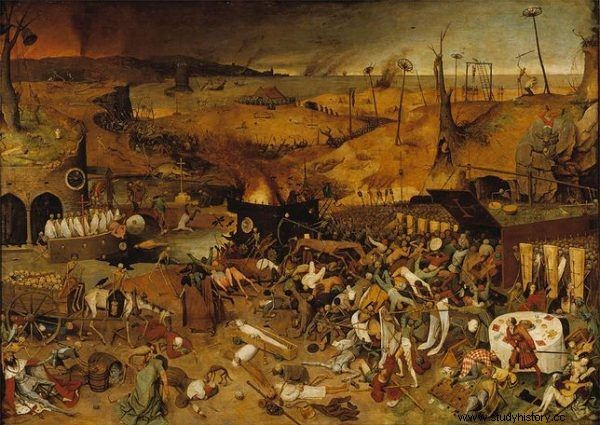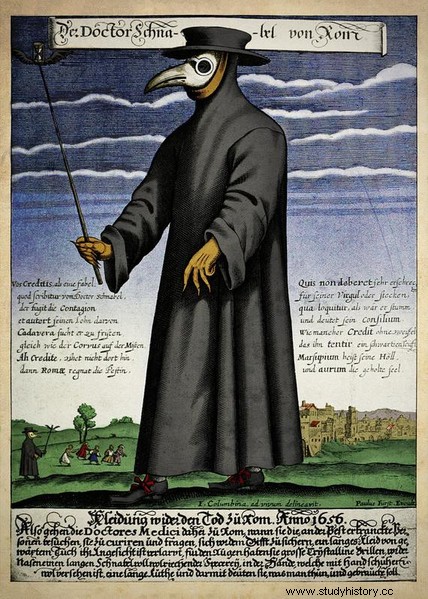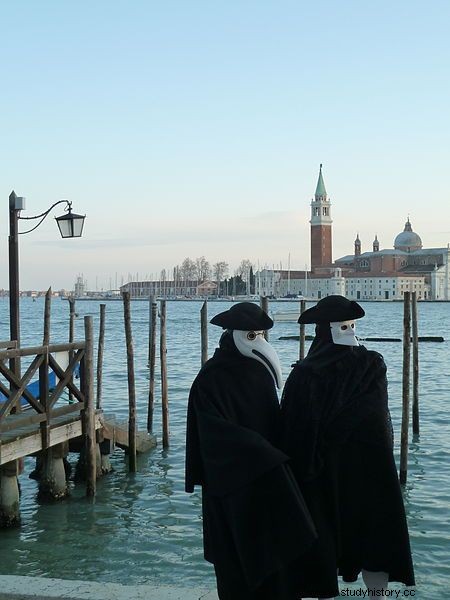The ubiquitous smell of sulfur and burning corpses. The groans of the dying and the cry of those who persistently cling to life. Church bells ringing and the whistle of whips lashing the flesh of sinners. A picture of hell circles? No, it's a day in the life of a plague doctor.
People have always been plagued by various cataclysms. They often severely affected local communities. The people of Troyes, for example, have been hit by three plagues in eight years. First, in 1180, it overflowed the Seine, contributing to the largest flood recorded in the city's chronicles. Four years later, the poor harvest in Champagne brought about one of the worst famines in Troyes history. And as if that were not enough, in 1188 a fire broke out in the city, which consumed a large part of the buildings, including the cathedral and the count's castle.
Bloody Harvest of the Plague
However, the greatest catastrophe was disease and plagues, as they were most often of a pandemic nature. Even for a modern man, they can be a challenge, let alone for people of ancient times, for whom the world often ended behind the walls of a city or behind a nearby forest. The plague has gained a peculiar but dismal fame in this regard. The one that hit the Eastern Roman Empire in 541–542 could consume approx. 5,000 a day. victims. However, its relapses over the next 200 years resulted in the death of nearly 50 million European population.

Plague was also called the Black Death
However, all this pales in comparison to what the autumn of 1347 brought, when 12 Genoese galleys nailed to the shores of the Sicilian Messina. It turned out that plague-infected refugees (including hundreds of disease-carrying rats) from Kaffa, besieged by the Golden Horde Khan of Janibeg, were on board. The Mongol commander, impatient with the resistance of the port inhabitants, used a bacteriological weapon there - used the bodies of those who died of the plague as catapult missiles which the unaware Chinese merchants brought to the camp. In this situation, whoever could escape to the West by sea, thus becoming the source of the epidemic in Europe.
God's rescue?
The people of Europe were not prepared for a disaster of this scale. Anyway, it's hard to talk about any kind of preparation, given the state of knowledge at the time. At first, it was considered a punishment for sins, and scientists from Paris blamed the plague on the unfavorable conjunction of the planets. Therefore, God saw the only salvation, and processions of flagellants appeared on the streets, which only contributed to the spread of the disease. > With time, it was concluded from their ignorance that the cause of the disease could be the so-called rotten air. It was supposed to cause that the plague was attacking other areas of the continent at an alarming pace. Therefore, the isolation of the sick was started, ranging from enclosing individual houses with walls, through literally walling up the infected, to prohibitions on entering ports of ships with crew suspected of being infected and using quarantine.

Plague Doctor Outfit
However, the number of victims continued to increase. Criminals were released from prisons, but it was not only an act of mercy, but a practical solution - there was no one to watch over them. Among the dead bodies and the dying littering the squares and streets, there were gloomy figures of medics who tried to help the sick on an ad hoc basis.
It must be remembered that the profession of a doctor fighting plague was very dangerous, but also lucrative. Medics were paid from the municipal treasury and from the private funds of the residents. This led to many abuses, and the vision of easy income tempted many a fraudster. They often tricked the families of patients into expensive and often absurd treatments. However, they did not differ significantly from the guidelines of professional doctors. It was recommended to light fires on street corners, sprinkle vinegar on coins and letters in circulation, and decontaminate with sulfur. Preparations made of unicorn horn (!), Goat liver, fish scales and toad hearts were commonly used. Of course, it could not do without the use of enemas, vomiting and the then antidote to everything, i.e. bloodletting. All these measures did not bring the expected results in most cases, and the plague had claimed one in three Europeans by 1352.
Plague Doctor
The Black Death also took its terrible toll in the 16th and 17th centuries. It was then that the characteristic protective clothing worn by doctors became the symbol of the plague. The physician of the kings of France, Charles de Lorme. He noted that the birds do not get plague, so the image of the bird can provide effective protection against the plague.
In his recommendations, however, he did not stop at scaring the disease with a bird's appearance. The beak, equipped with ventilation holes, was filled with herbs and aromatic oils, which were to filter the air and protect the physician from the plague. It was also recommended that full-body garments be made of Moroccan goat skins. The hat and gloves were also supposed to be leather. The whole thing should be impregnated with fragrant preparations.

The plague doctor's outfit has survived to this day in the form of characteristic Venetian masks
The plague doctor visiting the patient was to chew the garlic to strengthen the protective effect, and put sponges soaked in incense into his nose and ears. Some of the masks had a wedge inside, which the doctor held in his teeth. This imposed the necessity of preventive mouth closure. This made conversation with the patient impossible, making the medic even more mysterious, but it did not add to the personal charm. De Lorme is also credited with the idea of using a wooden cane to "remotely" examine patients to minimize the risk of contamination. However, despite his best intentions, the invention of the bird's outfit did not protect against the disease and the doctors themselves were also supporting the masses of victims.
Today it is difficult to ascertain how popular de Lorme's costumes were during the centuries of the plague. The chronicles are usually silent on this subject. To this day, few original specimens have survived, as many beaks and peculiar medical armor were burned together with the corpses of the infected owners. If you thought that with the advancement of medicine, bird masks have faded into oblivion, however, would be wrong. Yes, they are not worn by doctors anymore, but they are in common use during the famous Venetian carnival, among historical reenactors and clients of ... sex shops.
